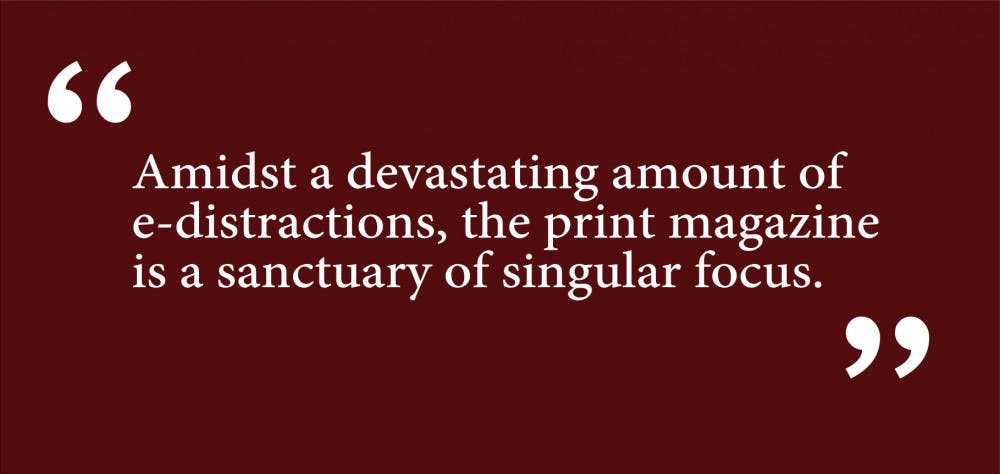Last week, Rolling Stone co-founder Jann Wenner announced the sale of the iconic publication that has been both reporting and influencing pop culture since 1967. The sale of the magazine demonstrates a broader decline in print media, which is a daunting subject to tackle in writing or even think about. I will always be a champion of physical copies, cherishing the illicit dog ears that track the quest through a novel and safeguarding that familiar scent that blankets any reader who finds themselves nose-close to a good story.
Although my literature-centric brain is usually focused on the closings of bookstores nationwide and the transitioning of traditional book sales to e-books, Wenner’s sale caught my attention as a particular omen of the demise of an era. Rolling Stone was once a symbol of counterculture relics. Now, perhaps, it also encompasses a time when print was in fashion. Even as print declines, we should still push ourselves to pick up physical copies of publications we love, given the benefits print provides.
In the dramatic twists of second grade, the only constant was the glimpse of a colorful cover of Highlights on the kitchen table, my name printed in the address box. American Girl and Seventeen were the silent instructors of confusing pre-teen years, not only ready to provide advice, but also to simply reassure me that everyone else had the same questions. In my current, extremely sophisticated collegiate life, the New Yorker is the reason I put up with the mailroom crowds every week. I flip to the comic contest first.
Clearly, print magazine subscriptions have much sentimental value to me. They have, in essence, chronicled my life, and I am sure others feel the same. Yet there are reasons beyond personal nostalgia to defend print journalism. Spotting another subway rider clutching the same issue of Time Magazine elicits similar feelings as conversations about the last night’s episode of “American Idol” once did, when no one was three seasons behind and everyone was ready to talk specifics of the most recent details. Netflix and binge-watching culture may have supplanted these moments in the television realm, but magazines allow a re-creation of this feeling in real time. The community behind a publication is physically visible through print distribution, fostering a profound sense of unity for its members.
Amidst a devastating amount of e-distractions, the print magazine is a sanctuary of singular focus. Rather than being tempted by the colorful floating dock of applications at the bottom of my screen when reading on my computer, having a publication in my hands allows me to read content free of distraction. Not surprisingly, studies have found that print readers retain plot information better than their Kindle counterparts, scoring significantly better on story comprehension assessments. Considering this disparity in comprehension between print and electronic readers, perhaps we can extend this to mean that the former establishes a connection with the text more easily and quickly. One study found that when reading an upsetting story on paper versus on an iPad, those who used print media scored higher on measures of empathy. In other words, reading anything from a New York Magazine article warning about climate change to a personal disclosure of fears with the repealing of the Deferred Action for Childhood Arrivals program in print would allow the best connection to the content. Not only being educated in a topic, but also feeling a personal connection to it is perhaps what motivates more genuine and impassioned engagement.
Though many publications provide great deals on their print subscriptions, the cost of buying print magazines often means reading articles online is more financially accessible. You can still read physical copies without a cost. Public libraries help make print publications more available. Walk a few feet off campus to the Providence Athenaeum’s vast collection of publications, free to explore. Pick up a copy of the New York Times in the Sciences Library’s lobby. In weighing your decision to splurge or seek out physical copies, consider the research that has shown the significant disparity in impressionability between print and online media. Besides the meaningful connection you might feel toward the text due to a surge in empathy, you will retain what you read in print much better than what you read online. In other words, you truly get what you pay for when it comes to swapping a URL for glossy pages.
On a local scale, the ability for student publications to distribute print versions is essential. Whether this involves an eager editor offering copies outside the Sharpe Refectory or a waiting stack of issues on the front desk in the Stephen Roberts ’62 Campus Center, the benefits extend past establishing and bonding a community of readers. It also increases the visibility and accessibility of these publications. Whereas a new first-year or a graduating senior may be unaware of some of Brown’s online gems, encountering a physical reminder of the existence of a publication increases awareness and readership. This is advantageous for both the contributors, whose work thus has a larger reach, and the readers, who reap the pleasure of reading something that could have remained hidden in the realm of online publications. And perhaps you’ll find that reading something in print, distraction-free, could be one of the highlights of your day.
Rebecca Okin ’19 can be reached at rebecca_okin@brown.edu. Please send responses to this opinion to letters@browndailyherald.com and other op-eds to opinions@browndailyherald.com.





